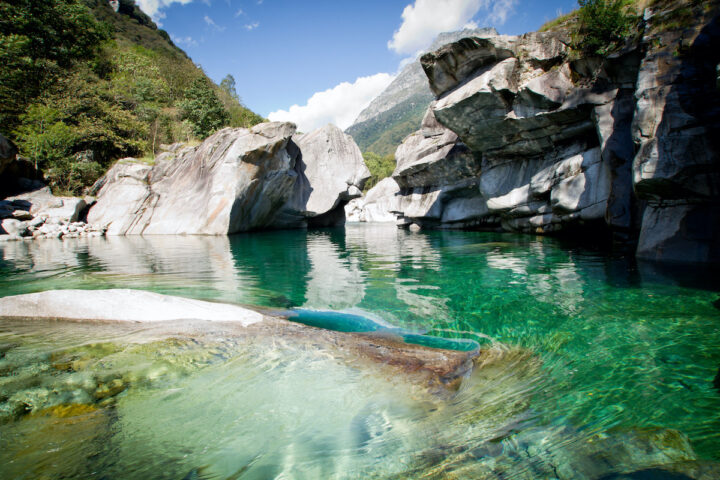
Pesticides in Water: The sources are more varied and closer than we think
A new national study reveals that pesticide contamination in Swiss rivers and streams has more complex causes than previously assumed. While substances still originate from agriculture, a considerable share enters waterways through other pathways.
Monday, October 27, 2025
As part of the National Surface Water Quality Monitoring Programme ('NAWA spez 2023'), the Swiss Federal Institute of Aquatic Science and Technology (Eawag), together with partner institutions, systematically investigated how pesticides make their way into surface waters. The result, published in early October 2025, is surprising: only part of the contamination can be traced back to diffuse runoff from crop production.
Many substances—particularly insecticides—originate from sources much closer to our everyday lives. Active ingredients such as imidacloprid or fipronil, which have long been banned as plant protection products, still reach rivers and streams via wastewater treatment plants. They come, for example, from flea and tick treatments for pets, from cleaning and disinfecting agents, or from wood preservatives. Residues can cling to animal fur, hands or textiles and wash off into sewage systems, eventually ending up in waterways. This shifts the focus—from the field to the laundry room. Laundry room? We’ve heard that before—right, glyphosate! A study showed that glyphosate can also form as a degradation product of certain detergents. Again, it’s clear that pointing fingers solely at crop protection products misses the full picture.
The new NAWA analysis highlights that everyone’s daily habits play a role. Pet owners who use certain insect repellents, for instance, may inadvertently contribute to water pollution. Likewise, cleaning products, biocidal sprays, or treated materials can add to the overall chemical load. Part of the problem, it seems, lies literally within our own four walls.
According to the definitions of the World Health Organization (WHO) and the Food and Agriculture Organization of the United Nations (FAO), pesticides are substances or mixtures of substances of chemical or biological origin used to repel or control pests, diseases, and weeds, as well as to regulate plant growth.
Pesticides are divided into biocides and plant protection products. The former protect humans, animals, or materials from pests and pathogens, while the latter are designed to protect plants.
From an ecotoxicological perspective, insecticides remain the main risk drivers for aquatic organisms. In the study, concentration limits were exceeded particularly for cypermethrin, imidacloprid, metazachlor, metribuzin, nicosulfuron, and thiacloprid. Many of these substances are now banned as plant protection products but continue to circulate as biocides or veterinary medicines. Even after regulatory action, these compounds persist in the environment.
A Broader Focus Is Needed
Pathways of entry differ significantly by substance. Diffuse runoff is typical for current crop protection products such as aclonifen, which are washed off fields during rain. Entry via wastewater treatment plants, on the other hand, is characteristic of substances from non-agricultural uses, such as imidacloprid or fipronil. Many substances follow both pathways in parallel, depending on location and use. The responsibility is therefore widely shared. Not only farms but also households, veterinarians, small businesses, and consumers contribute to the chemical burden on surface waters.
The study makes one thing clear: pesticide contamination is not solely an agricultural problem. The pathways are diverse—and some lead directly from our bathrooms and laundry rooms into the streams. Protecting our waters therefore begins not only in the fields, but also at home.
Blindspot article
Sources
Kindly note:
We, a non-native editorial team value clear and faultless communication. At times we have to prioritize speed over perfection, utilizing tools, that are still learning.
We are deepL sorry for any observed stylistic or spelling errors.
Related articles

Facts about drinking water and limit values
'Pure' water is either a tasteless distillate or a selling point. As natural products, neither tap water nor branded water is 'pure'. However, both can be drunk without hesitation.

Mystery of Glyphosate’s Origins
For a long time, the answer seemed clear: agriculture was to blame. But new research turns this assumption on its head. A trail of clues leads from fields and garden fences deep into the wastewater system—and ends with a surprise.

Residues, thresholds, trust – looking calmly behind the headlines
In this conversation with toxicologist Lothar Aicher, the discussion focuses on how residues enter the body, how their potential harm is assessed, and what role modern analytical methods play.

Hazard is not the same as risk: how we understand – and should understand – threshold values
In this episode of the podcast, risk researcher Angela Bearth discusses residues and threshold values in food – a topic often debated emotionally. In public discussions, threshold values tend to dominate, while the complex challenges of agriculture are rarely considered. Studies show, however, that once these relationships are explained and solutions are addressed, people respond in a more differentiated way.

PFAS, trade-offs and responsibility – how politics and agriculture find solutions
In this episode of the joint series by Agrarpolitik – der Podcast and swiss-food.ch, National Councillor Christine Badertscher discusses how residues and threshold values are debated in Parliament.

Thresholds, approvals, responsibility – how plant protection products are really assessed
Threshold values are often at the centre of public debate – yet in reality they are only a small part of a much broader risk assessment system. Dr Michael Beer, Head of the Food and Nutrition Division at the Federal Food Safety Office, provides clarity.

